Turkey
Highlights
- Solid growth in Turkish lira activity, despite less use of the CGF program.
- Very positive trend in more recurring revenue items.
- Operating expenses growing below in ation and gross income.
- Improvement in asset quality indicators, which continue to outperform the rest of the sector.
Business activity (1)
(Year-on-year change at constant exchange rate. Data as of 30-09-2017)
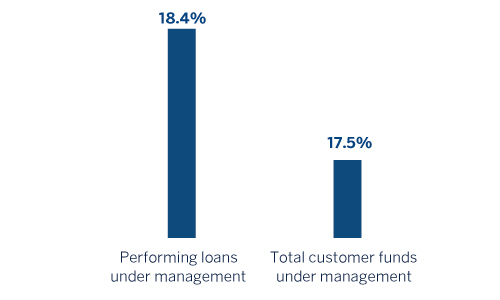
(1) Excluding repos.
Net interest income/ATAs
(Percentage. Constant exchange rate)
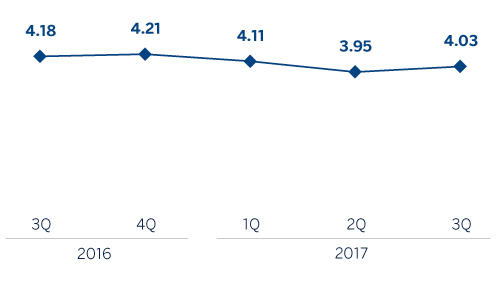
Operating income
(Million euros at constant exchange rate)
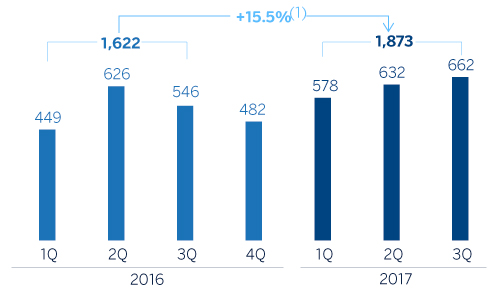
(1) At current exchange rate: -5.5%.
Net attributable profit
(Million euros at constant exchange rate)
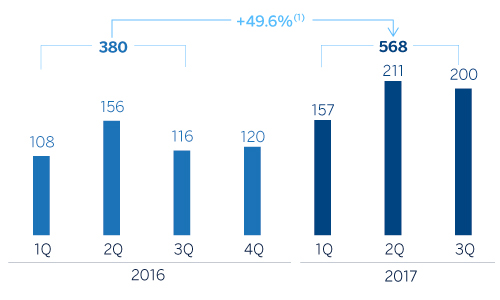
(1) At current exchange rate: +22.5%.
Breakdown of performing loans under management (1)
(30-09-2017)
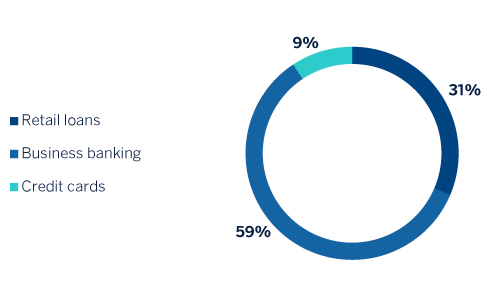
(1) Excluding repos.
Breakdown of customer funds under management (1)
(30-09-2017)

(1) Excluding repos.
Macro and industry trends
According to the most recent figures from the Turkish Statistical Institute, economic growth stood at 5.1% in year-on-year terms in the second quarter of 2017. Investment and private consumption were the main contributors whilst the contribution of government spending was negative for the first time in the last nine quarters. Government stimuli appear to be leveraging growth via private consumption, which is increasing household confidence, and by encouraging investments, through access to credit facilities fostered by the Credit Guarantee Fund (CGF). BBVA Research has therefore revised its forecast up to 6% for 2017.
Headline Inflation has remained high, rising. It rose to 11.2% as of September, 2017. Core inflation hit double digits, though negative food inflation prevented headline inflation from climbing further.
As inflation has remained in double digits, the CBRT has kept its monetary policy tight. Since the end of last year, there has been an increase of around 368 basis points in the average funding rate (from 8.31% to 11.99%). Currency depreciation is expected to continue in the medium term.
The Turkish financial sector has showed signs of moderation. Although the year-on-year growth rate in total lending (adjusted for the effect of the depreciation of the lira) increased to 20.4% at the end of September (compared to 17.7% as of June), the last 13 weeks trend decreased from 29.2% to 14.5%. This slowdown came mainly from commercial lending, which is in a cooldown after the initial boost from the government’s CGF program. Deposit gathering , also adjusted for the effect of the depreciation of the lira, continued to grow to around a year-on-year 12.1% as of September. Foreign-exchange deposits grew by 16.2%, mainly due to the comparison with the exceptionally low figure in this period last year. The NPL ratio remained close to 3.1%.
Activity
In March 2017, BBVA completed the acquisition of an additional 9.95% stake in the share capital of Garanti, increasing BBVA's total stake in this entity to 49.85%, which continues to be incorporated into the Group's financial statements by the full integration method.
Unless expressly stated otherwise, all the comments below on rates of change, for both activity and earnings, will be given at constant exchange rate. These rates, together with changes at current exchange rate, can be seen in the attached tables of financial statements and relevant business indicators.
The solid growth of lending activity (performing loans under management) in the area has been maintained. The total portfolio posted a year-to-date growth rate of 8.8%, driven once more by the Turkish lira loans. Foreign-currency loans continued their declining trend. By segments, business banking loans grew at a lesser pace in the last three months. The reason is that Garanti was one of the first banks to benefit from the aforementioned CGF program, which is backed by the Turkish Treasury to foster commercial loans. Currently, Garanti has reached its limits in this program for the quarter, while the public banks have been increasing their exposure to these kinds of loans. Consumer loans continued to perform favorably, with a stronger price discipline. However, public banks have shown more risk appetite in the last three months. General purpose loans and credit cards also performed well. Additionally, the positive trend in mortgage loans continued among the private banks, including Garanti. It is worth noting that Garanti is strengthening its market position in the credit card segment, mainly thanks to the increase in commercial credit cards. In addition, Garanti recorded a higher growth in consumer lending than its private peers (up 20.9% from December and up 5.5% from June).
In asset quality, the NPL ratio remained stable at 2.5%, well below the sector average thanks to weak NPL inflows. The NPL coverage ratio stands at 138%.
Customer deposits remain the main source of funding for the balance sheet in the area, and grew by 9.9% in the last nine months (up to 2.1% in the quarter). Turkish lira customer deposits were strong due to the shift from foreign currency deposits. There was a good performance by Turkish lira current and savings customer deposits, which continued to support funding, at almost zero cost. The total volume of funds in current and savings accounts represents 24.3% of total customer deposits as of 30-September-2017.
Results
Turkey has generated a cumulative net attributable profit of €568m through September 2017, up 49.6% on the figure in the same period in 2016. The most significant aspects of the year-on-year changes of the income statement are as follows:
- Positive performance of net interest income (up 16.5% year-on-year and 3.4% over the quarter). This positive trend is a result of increased in activity, good management of customer spreads (despite the CBRT tight monetary policy), higher securities income (as a result of an increase in the base inflation estimates made in the previous quarter and used for the valuation of CPI linked bonds) and a slight rise in security portfolio volume.
- Income from fees and commissions continues to perform well, both in the quarter (up 7.4%) and year-on-year (up 13.6%), thanks to good diversification (payment systems, money transfers, loans, insurance, etc.). This positive performance has been achieved despite the lower generation of fees for account maintenance due to the suspension of charges in the retail segment implemented by the Turkish Council of State as of January, 2016, and the high revenues generated in the same period of 2016 by the Miles & Smiles program.
- Reduction of NTI (down 78.8%) mainly due to the higher base of comparison because of the capital gains generated in the first half of 2016 from the VISA deal.
- Overall, gross income was 12.9% higher than in the first nine months of 2016.
- Operating expenses increased by 8.8%, below both the inflation rate and the year-on-year growth rate showed of gross income, thanks to strict cost discipline. As a result, the efficiency ratio declined to 37.7% (38.4% in the first half of 2017 and 40.8% in 2016).
- Impairment losses on nancial assets decreased once again (down 8.1%). As a result, the cost of risk in the area closed the first nine months of 2017 at 0.83%.
- Finally, BBVA Group’s additional stake of 9.95% in Garanti’s capital had a positive effect of reducing the non-controlling interest heading by approximately €93m.
Financial statements and relevant business indicators (Million euros and percentage)
| Income statement | Jan.-Sep. 17 | ∆% | ∆%(1) | Jan.-Sep. 16 |
|---|---|---|---|---|
| Net interest income | 2,399 | (4.6) | 16.5 | 2,516 |
| Net fees and commissions | 537 | (7.0) | 13.6 | 578 |
| Net trading income | 22 | (82.6) | (78.8) | 124 |
| Other income/expenses | 50 | 32.3 | 61.6 | 38 |
| Gross income | 3,008 | (7.6) | 12.9 | 3,255 |
| Operating expenses | (1,135) | (10.9) | 18.8 | (1,274) |
| Personnel expenses | (605) | (9.2) | 10.9 | (666) |
| Other administrative expenses | (392) | (11.4) | 8.3 | (443) |
| Depreciation | (137) | (16.7) | 1.7 | (165) |
| Operating income | 1,873 | (5.5) | 15.5 | 1,981 |
| Impairment on financial assets (net) | (352) | (24.8) | (8.1) | (468) |
| Provisions (net) and other gains (losses) | (12) | (69.7) | (63.0) | (38) |
| Profit/(loss) before tax | 1,510 | 2.3 | 25.0 | 1,475 |
| Income tax | (308) | 1.6 | 24.1 | (304) |
| Profit/(loss) for the year | 1,201 | 2.5 | 25.3 | 1,172 |
| Non-controlling interests | (634) | (10.5) | 9.3 | (708) |
| Net attributable profit | 568 | 22.5 | 49.6 | 464 |
| Balance sheets | 30-09-17 | ∆% | ∆%(1) | 31-12-16 |
|---|---|---|---|---|
| Cash, cash balances at central banks and other demand deposits | 3,547 | 30.2 | 47.6 | 2,724 |
| Financial assets | 11,956 | (12.5) | (0.9) | 13,670 |
| Loans and receivables | 62,349 | (3.8) | 9.0 | 64,814 |
| of which loans and advances to customers | 53,203 | (4.3) | 8.4 | 55,612 |
| Tangible assets | 1,355 | (5.2) | 7.4 | 1,430 |
| Other assets | 1,803 | (19.1) | (8.3) | 2,229 |
| Total assets/liabilities and equity | 81,010 | (4.5) | 8.2 | 84,866 |
| Financial liabilities held for trading and designated at fair value through profit or loss | 553 | (45.1) | (37.8) | 1,009 |
| Deposits from central banks and credit institutions | 12,589 | (6.7) | 5.8 | 13,490 |
| Deposits from customers | 45,650 | (3.4) | 9.5 | 47,244 |
| Debt certificates | 8,082 | 2.2 | 15.8 | 7,907 |
| Other liabilities | 11,487 | (10.9) | 1.0 | 12,887 |
| Economic capital allocated | 2,648 | 13.7 | 28.8 | 2,330 |
| Relevant business indicators | 30-09-17 | ∆% | ∆%(1) | 31-12-16 |
|---|---|---|---|---|
| Loans and advances to customers (gross) (2) | 55,486 | (4.2) | 8.5 | 57,941 |
| Non-performing loans and guarantees given | 1,727 | (12.9) | (1.2) | 1,982 |
| Customer deposits under management (2) | 46,032 | (3.1) | 9.9 | 47,489 |
| Off-balance sheet funds (3) | 3,914 | 4.3 | 18,2 | 3,753 |
| Risk-weighted assets | 64,611 | (8.1) | 4.1 | 70,337 |
| Efficiency ratio (%) | 37.7 | 40.8 | ||
| NPL ratio (%) | 2.5 | 2.7 | ||
| NPL coverage ratio (%) | 138 | 124 | ||
| Cost of risk (%) | 0.83 | 0.87 |
(1) Figures at constant exchange rate.
(2) Excluding repos.
(3) Includes mutual funds, pension funds and other off-balance sheet funds.